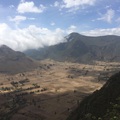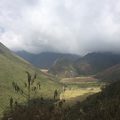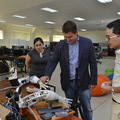28-30.08.2015.
Chimborazo and La Mitad del Mundo
One Ecuadorian friend of mine invited me to Riobamba and to a hiking on Chimborazo. So on Friday I travelled 4 hours to reach the city, which is even bigger than Loja. The highway led me next to the fuming Cotopaxi, which was erupting with a renewed force, spitting ash and gases, brought by the wind (fortunately) away from Quito. For kilometres long the fields are covered by ash and dust, making the whole landscape grey. The Chimborazo vulcan is 6268 m high (above see level), however measured from the centre of the Earth it is fairest point. So it was obligatory for me to climb it. Although I couldn't reach the top without special equipment, I could reach on foot a laguna (reserving the melting water of the mountain) on 5060 m above see level. From the first refugee house on 4900 m e 1.5 km path was an hour and half walk... I had to stop every half minutes, every step was a huge effort due to the anoxic high-altitude air.
On Sunday we went to the Middle of the World (La Mitad del Mundo) where the equator is running through, 30 km North of Quito. In the city's Intiñan Museum one can see the effects of the equator, for example the running out of the water in sinker. On the line of the equator the water is running out directly down without any swirl. Two meter north of the equator it is running down with swirling right, as we are used to it in Europe, however two meter south it is swirling onto the left. This is the well known Coriolis effect, but the strength of it just two meter away of the equator is astonishing.
After this we climbed down to the biggest volcanic crater of Latin-America, which is called Pululahua. There is a strange microclimate with fertile soil and intense agricultural production in the crater, which is inactive for more than 2500 years, when the last eruption happened. The view from the mountain down and from the crater above was equally beautiful with mountain tops covered by clouds and eagles flying and floating in the wind.



